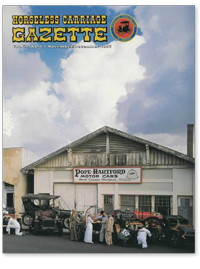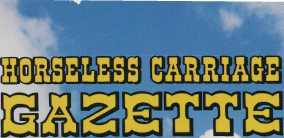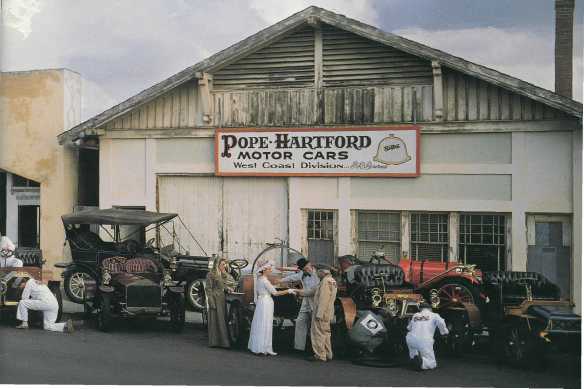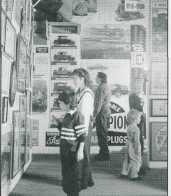
Horseless Carriage Gazette 1997
Announcement: Museum of Automobile History in Syracuse, New York
 |
 |
||
 |
|||
|
|
||||
|
ANNOUNCEMENTS
|
The museum takes visitors through two hundred years of the automobile age, with more than 10,000 items pertaining to more than 1,000 makes of automobiles, motorcycles and trucks. It evokes the world that the automobile left in its wake, in extensive displays of advertising, posters, toys, models, design drawings, fine art, folk art and more.
The Museum of Automobile History grew out of the lifelong collection of Walter Miller.
For more than 30 years he roamed flea markets and fine antique shops around the world looking for items that connected people to cars. Walter would be just as interested in an old family photo of two kids playing in a truck as he was in a rare automobile oil painting, as interested in a DeSoto billboard, 20′ wide, as he was in a model sportscar hand carved in wood. The history of the automobile is in all of it. "There isn’t a person living in America today whose life wasn’t influenced or shaped by the automobile," says Walter.
Amassing the collection combined his business experience as the leading dealer in automobile literature in the world and his academic training as a historian. By the time he was ready to put part of his collection on public display, it required 12,000 square feet in rooms with 25-foot ceilings.
|
The Museum of Automobile History literally stops traffic. The exterior is lined with 20 authentic full color billboards-each measuring twenty feet by ten feet-advertising America’s favorite family cars of the "40s and ’50s. Passersby do a double-take, because many of the makes advertised aren’t for sale any more. It’s no dealership, but the biggest collection displayed anywhere of authentic, original colorful and memorable automobile billboards.
Inside, the space is modern and well-lighted, designed by noted Syracuse architect Robert Levy. Visitors can look for items related to their favorite cars or follow a chronological route through the running display of memorabilia. It starts with original newspaper accounts of the inventions that preceded the automobile and proceeds to touch on every type of car created ever since. In fact, one of the rare items on display is the autograph of Charles Duryea, one of the men credited with building America’s first production automobile in 1896.
Other items on display are movie posters from car-crazy Hollywood pictures, fine oil paintings and drawings by serious American and European artists, design models used by Detroit stylists, war posters from around the world showing cars in battle, letters from auto designers and executives (including Henry Ford II, Ransom Olds, Raymond
|
||
 |
||||
|
If just one museum could reflect all that the car has meant for the last one hundred years, it would be the new Museum of Automobile History in Syracuse, Hew York. Beginning with the largest private collection of automobilia in the world, the museum is literally a "memory lane" for every generation.
|
||||
|
|
||||
|
|
||||
|
Loewy, E.L. Cord, Ferry Porsche and Walter Chrysler), racing memorabilia, cartoons, thousands of toys, games and children’s books that helped to raise kids in a car world, rare auto accessories and gadgets. It is a walk through a time machine of the automobile age.
Cars are even in the air. Visitors touring the galleries hear original radio advertisements and musical jingles for great cars. With hundreds of hours of recordings available, visitors aren’t likely to hear a repeat.
The museum is also on the move with video. Race footage, vintage television-ads and historical documentaries run on a large screen, set on the back of a miniature truck. Visitors can opt to sit for a while, to watch the auto age in action.
"The main focus," says Walter, "is that there is no focus. Most collectors are into one aspect or another of the automobile-mascots, for instance or a particular type of car like Packard. My eye has taken in anything related to the car. That’s the effect that I want."
Objects ranging from Flintstone and Batman toy cars to rare large-scale Detroit automobile-design models, from unique radiator caps to cars made to scale in wicker, clay, wood, tin or cloth are in the second main room.
The museum’s fine art collection (concentrated on the walls surrounding the cases) includes more than 1,000 paintings and pencil sketches, many by renowned European and American artists.
Nearly anyone who visits the museum will see a car or an ad or a picture that reminds him of his own bit of automobile history. Taken altogether, though, the experience is more than that. Walter worked closely with curator Elisa Deyneka to organize the many thousands of items into a total effect that is even greater than the sum of those many parts.
"Technology is moving so fast that people under thirty don’t know a world without computers," Walter says. "People under 50 don’t know one without television. Almost no one living today remembers the world without automobiles. Unless you live without something, you take it for granted. People of any age will emerge with an understanding of why the auto has been the single most important invention of our time or of all time," Walter explains.
Automobiles themselves, while they are beautiful to look at, don’t mirror the people who used them, sold them, made them, loved them and even hated them, as vividly as the unexpected items left behind by those people. Walking through the Museum of Automobile History, a visitor can dis-
|
cover just how our whole nation—our whole planet—took to wheels.
In building the collection, Walter purchased several major collections. One of the first was the personal library of Floyd Cly-mer, the well-known publisher of automobile books from the ’30s to the ’60s and former president of the Horseless Carriage Club. Visitors to the museum will see personal letters written to Clymer by such notable figures as Ransom E. Olds and Henry Kaiser.
Another collection which helped to shape the museum is that of the late J.L. Elbert, author of a respected book on the Duesen-berg written in 1949. A resident of a small town in Missouri, he was dedicated to the beauty and importance of automobilia, amassing one of the largest collections in existence, that included, among other things, showroom brochures from nearly every automobile made from his youth during the ’20s until the 70s when his house was literally filled to the brim.
During his lifetime, Elbert personally wrote more than 100,000 letters requesting sales literature of auto manufacturers worldwide. In fact, the collection filled two tractor-trailers when it was moved. Walter Miller has dedicated the Museum of Automobile History to the memory of J.L. Elbert.
Walter travels extensively and, along the way, his eyes are always open for items related to the automobile. "I was in Russia for a month," he recalled, "and I took the trans-Siberia railway. Every time the train stopped, there’d be peddlers waiting, and every time, I’d get a little Russian toy car: about 20 different models of cars which aren’t being made anymore."
At a street market in front of the Red Fort in New Delhi, India, one of the vendors had some antiques for sale. Rummaging around, Walter found a rusty automobile model on a tabletop, handmade in brass to hold spices. He judged that it was from the ’20s when India was part of the British Empire.
"In Mexico one time, I saw some peasants selling religious icons, some of which were shaped like cars filled with skeletons!" Walter recalled. These items from Russia, India and Mexico are on display.
As a historian, he sees the serious purpose behind the items that visitors will see at the museum. Walter points out that there is no museum like it anywhere else in the world.
In the first place, there are no cars at this "car museum". That, by itself, makes a bold statement. D
Museum of Automobile History
321 M Clinton St
Syracuse MY 13202
315/478-2277
|
* FOUNDATION NEWS *
The Horseless Carriage Foundation Research Library in La Mesa, California has a new addition to its decor. Installed in September and dedicated to the generous supporters of the foundation during the 100th Anniversary of the American automobile industry, a large plaque now graces the trophy wall of the library’s reading room. It recognizes those who responded to the Centennial Patron appeal begun in 1995.
One hundred thirty-five names of individuals and organizations are inscribed on this handsome bronze and wood tablet. Each represents a donation of $100 or more toward the work of the HCF Library.
We are grateful for the tremendous support of members of the Horseless Carriage Club. You may have noticed that each year we take on the appearance of your local PBS station when we make an appeal to HCCA members through the annual dues renewal mailout. Your response has been heartening. Without your continued support, we wouldn’t exist.
As a 501(c)(3) non-profit public benefit organization, we are completely dependent on your donations of money, literature, automotive memorabilia and cars.
Consider a donation to the Horseless Carriage Foundation in your will, trust or other estate planning. All contributions are tax deductible to the extent allowed by law. Call us at 619/464-0301 and we’ll give you a hand. D
Jack R. Garrison HCFI president
* LETTERS *
I just received my July/August Horseless Carriage Gazette and was very pleased to see on page 37 a photo of the 1904 Oldsmobile that my late father restored in the late ’60s.
This little car was restored in an open shed starting with incomplete remains. Many items, including the brass radiator, had to be made at home from scratch.
One of the most memorable moments during the restoration was when the French doors were opened up and the body was carried into the dining room of the house so that my mother could do the upholstery. . It is interesting to note that this particular car is actually a Canadian-built Oldsmobile. Research at the time indicated that when Oldsmobile of Canada was starting up, initial production cars were built under license by the Packard Electric Company (no relation to Packard automobiles).
|
||
|
|
||||


